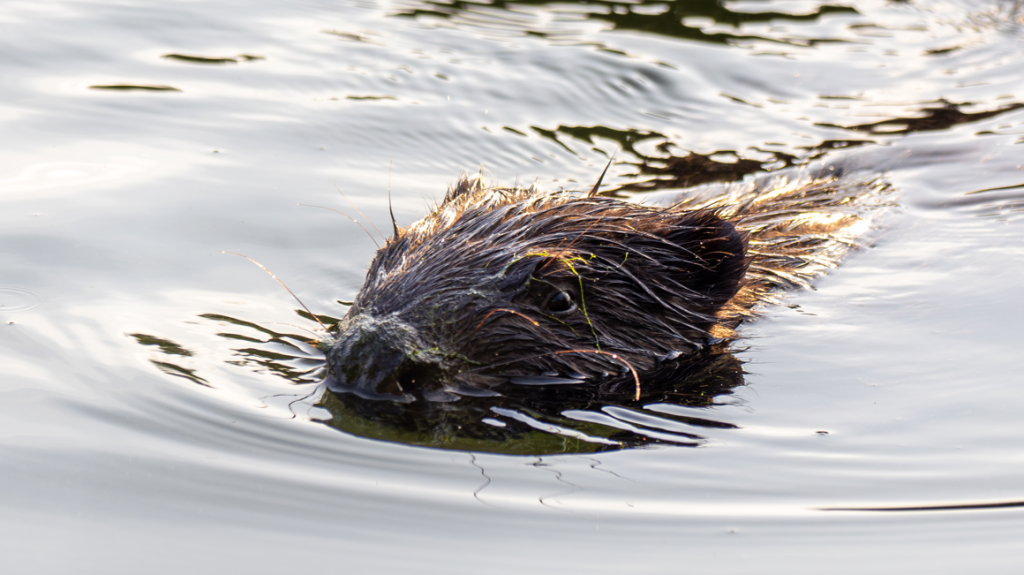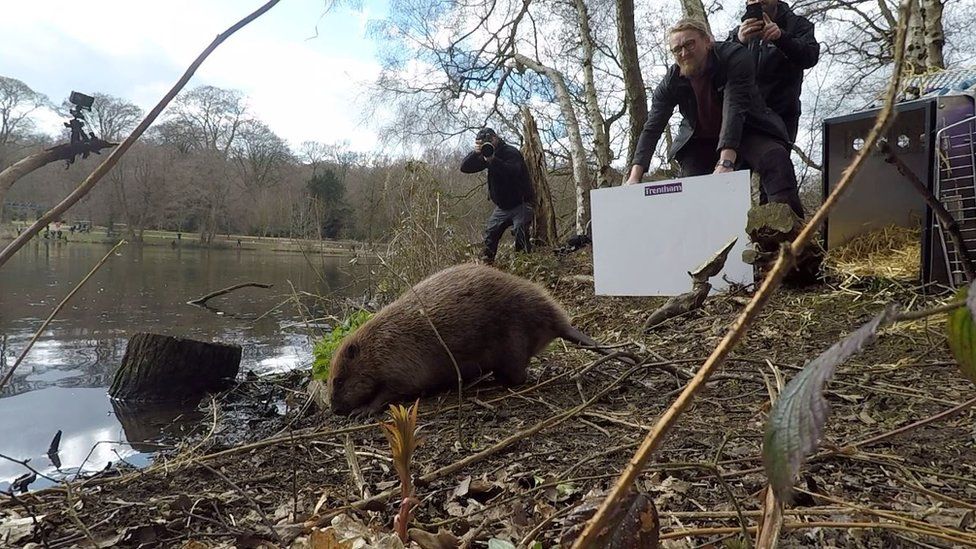Beaver Translocation Update at Trentham

This autumn there are exciting developments ahead for the long-term future of Trentham’s resident family of Eurasian Beavers.
Since the translocation and introduction of our family of three Eurasian beavers to the Trentham Estate on 27 March 2023. A dominant pair and one yearling female kit from their previous litter. There has been very little need for direct hands-on management of the beavers themselves. We have closely monitored their behaviour and health via our network of camera traps and occasionally had to protect valuable trees on site and tidy up some of their felling activity.
Since their arrival, the beavers have been a big success, with litters of kits in 2023 and 2024, raising our family to a total of eight. As well as the beavers enthusiastically contributing towards the management of the lake side vegetation. These natural ecosystem engineers are an amazing resource in better managing the tree and scrub growth on and around the lake, helping to restore the historically important views across the lake while at the same time creating valuable habitats for other resident species.
With the sad death of natural causes, of our dominant female in May this year, we have had beaver sized hole within our family group. Now is the perfect time to identify the gender of the five beavers born here at Trentham and move those ready to breed off to new territories with potential new partners from other families. So, this autumn we will be working closely with the Beaver Trust and Natural England to safely and humanly capture all our beavers in order carry out routine health checks and confirm the gender of the Trentham born beavers.
In addition, we will also be preparing for the future introduction of a new dominant female to pair up with our resident dominant male. This will involve translocating all our resident female beavers to suitable new homes. These new homes will be arranged via our project partners and in line with national legalisation. We hope to update our customers with details of their new homes in due time.
Why are we moving some of our beavers on you may ask? Well, it’s all to do with natural beaver behaviour, politics and maintaining suitable genetics within our family group. With the loss of our dominant female, there is now a space in the family hierarchy for a new dominant female. This would most likely fall to the oldest known female in the family, who is the daughter of our breeding pair. This would be an unfavourable breeding between close family members. So, there is a need within our enclosed population for a new dominant female. To make sure the arrival of new female goes smoothly with as little conflict as possible and avoid unwanted breeding between family members occurring this breeding season (December to February), its important that we remove all the resident female beavers this autumn.
Following on from this planned work this autumn, there would also be the need to remove all our male beavers apart from our resident dominant male in 2026 so that when the new love interest arrives for our resident male that he does not potentially see his male offspring as competition and for conflict to occur between males.
We are planning on spreading the required translocations over the next year to maintain suitable beaver numbers on site both for visitor safaris and so that our beavers can continue to assist with lake margin management. Removing beavers gradually over a longer term will reduce sudden upheaval within the family group and stress to our resident male beaver.
Our Wildlife Rangers will be available for drop in question and answer sessions at 8.30am and 12pm every day, from Monday 18th to Friday 22nd August 2025, at Trentham’s Ranger Station.

Frequently Asked Questions
Why are the beavers being trapped? Following the death of the dominant female we need to ID the age and sex of the kits from 2023 and 2024 to identify females as well as ID and remove the original daughter. This is so the females can be removed from the enclosure to prevent interbreeding with the father or young males.
Why can’t you identify the gender of beavers without trapping them? Male and Female beavers are indistinguishable without a more detailed physical examination and the obtaining of anal gland secretion. Which can only be obtained through safe trapping and handling of the beavers
Is there a risk of injury or distress to the Beavers or other wildlife? Our trained specialist team will be working with Beaver Trust staff. We will be using Bavarian Beaver Traps which are widely used across Europe and the UK. These have been specially designed to be safe and humane. Please do not approach traps as scent causes distress. It is important the beavers are caught before they start to interbreed.
Beavers cannot be tranquilised as they always head to water as their safe place, which when sedated is dangerous.
We will be keeping the Beaver family together in a specially designed small enclosure during the trapping process to reduce stress as they are unlikely to be all caught in the first few days, this also reduces the risk of re trapping individuals who are tempted by the treats put out.
Do the beaver traps pose a danger to the public or dogs? No, these traps are purposely designed and built for beavers. All baited and set traps will be removed from the path, with clear signage visible and roped off with a large no access buffer zone. But we do remind all visitors and members to supervise small children at all times and keep dogs on short leads.
How long will it take to trap and health check all the beavers at Trentham? Processing each animal will only take a short time. The length of time to catch all the individuals is up to the beavers, but could take as little as a few weeks or be considerably longer. We are scheduling to be actively trapping between mid September and the end of November
Why weren’t beavers health checked before? Beavers health can be easily determined by looking at their coat condition, tail condition and general size/weight, which we have been carrying out throughout their time here. Physical checks like weight and length will be done when we are checking their gender. Wild beavers will be caught to carry out blood tests to ID genetic profile and check for general health. Trapping of beavers can cause low levels of stress to the beavers and may make them less likely to enter a trap in the future(Trap shy). So, it is advised to avoid trapping beavers unless necessary and without good reason.
Where will the translocated females go? The genetic profile of these animals is known so they will be introduced to enclosures or wild releases where this will support healthy breeding of the population.
What is happening to the male beavers? As they are a family group they can remain together without high risk of infighting and risk of injury. At an appropriate stage we will look to remove most of them to allow for the introduction of a new female genetically selected to be a suitable dominant female and to start a new breeding family.
A female will only be introduced to a male as she will be aggressive towards the animals she does not select as she tries to establish her new territory. Although our beaver enclosure is the largest in the UK we will want to remove all additional males to avoid risk of injury.
Will this impact beaver safari sightings? We are planning to reduce our beaver population over two years to maintain suitable numbers on site and ensure that our beaver safaris continue to be a big hit with visitors. We will also be able to give more insights and information about beaver translocation as the project
Why might the male beavers wait until next breeding season before we move them? All our translocated beavers will need to go to Natural England approved translocation projects either to wild release locations or enclosures. Although the legislation has been put in place for wild releases this year (Spring 2025) it takes a while for all the landowners and other stakeholders/ communities along the river catchments to be consulted. Approved release sites are used for wild beavers needing to be relocated because they have established their territory within an unsuitable (for humans) environment. In these instances they are prioritised for a move to minimise impact on landowners activity or important infrastructure. It is likely that there will be significantly more approved release sites available in 2026/2027 so we might keep our boys together as they are happy here in the interim.
Will the adult beaver be replaced? The adult female is the matriarch of the family and will be the only breeding female in a family group. We will under license bring a new adult female in to this family group after younger females have been relocated to pair with a male and continue mixing the genetic diversity of Eurasian Beavers.
Do we intervene on wildlife well being on the estate? Our experienced estates and wildlife rangers will assess and take appropriate action when needed following the regulations laid out the Wildlife and Countryside Act and when appropriate consult with appropriate organisations and professionals.